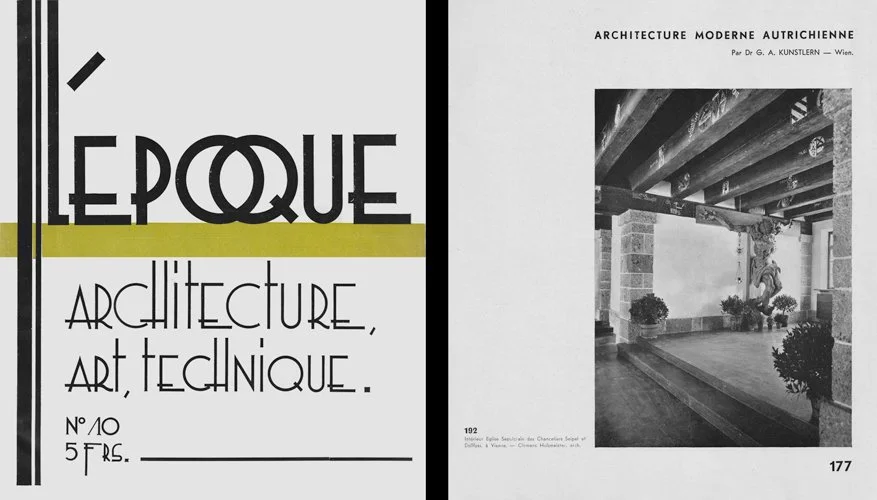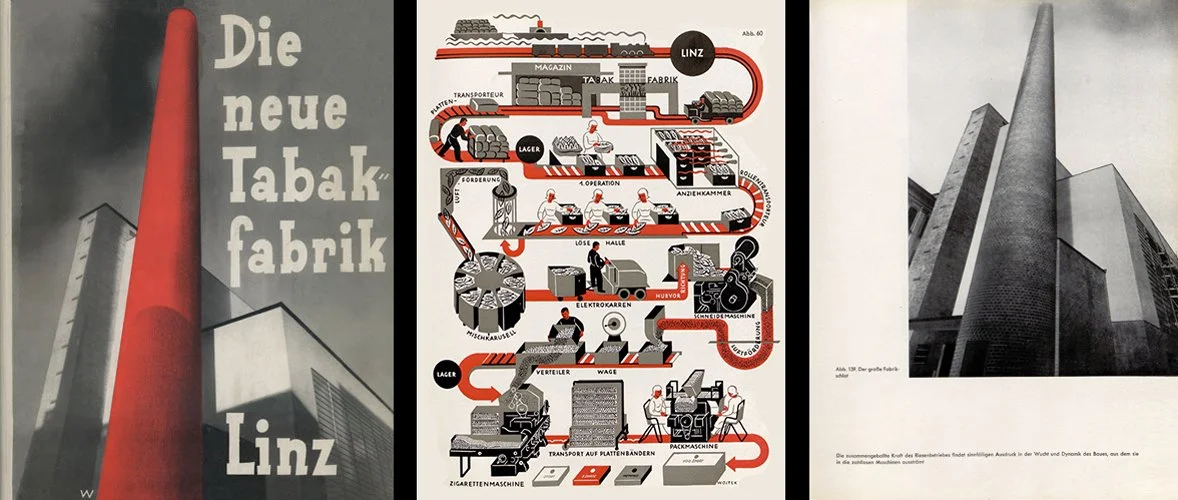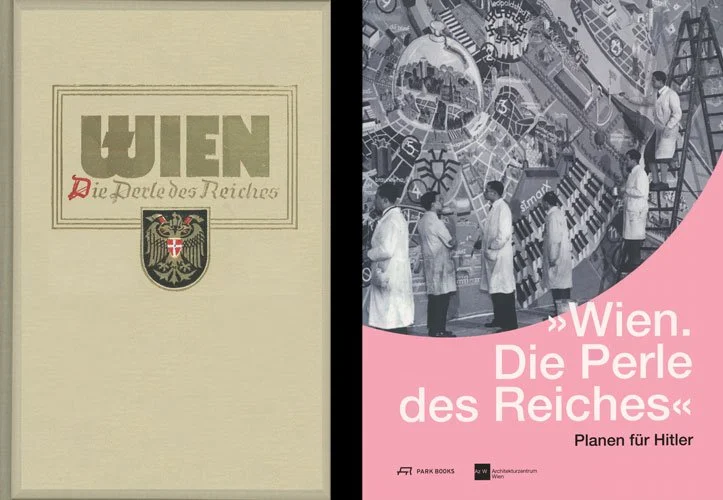Black Vienna – Publications 1934-38
⭆ Collecting | A denied topic of Vienna's urban developmentWith the establishment of the dictatorial Dollfuß/Schuschnigg regime and the fall of Red Vienna, the municipal housing programme finally came to an end in 1934 after only 11 years. The change of regime was forced by gun violence and especially in Vienna civil war-like fighting broke out. The facist dictatorship claimed to establish a corporative state in Austria. The May Constitution of 1934 was to become the basis of a "social, Christian, German state of Austria based on the estates", which opposed the idea of socialist class struggle. It aimed at a corporative-feudal model of society supported by the Catholic Church – the so-called Austrofascism.
The new Viennese major Richard Schmitz attempted a reorganisation of the city in Black Vienna. The models were European dictatorial urban planning strategies of the 1930s, especially the fascist, Italian urban planning of Rome. Vienna was to become a city of traffic. To this end, the intervention in the historically developed residential building fabric by means of redevelopment, as well as the adaptation of roads and bridges for individual traffic were forced. Monumental buildings and administrative buildings were to be erected in the historic centre. Due to a lack of financial means, however, no far-reaching urban redevelopment took place.
In Austrian historiography, the four years of Austrofascism until the 'Anschluss' to Hitler's Germany in 1938 have so far always been presented as a kind of transitional period, and there hardly was any secondary literature on the aspect of urban development of this time. This gap was only closed in 2022 with the brilliant book by architectural historian Inge Podbrecky.Der Fall der roten Festung. Josef Schneider, Carl Zell. Vienna: Manz (1934)
Two postcards showing the artillery damage to the Goethe-Hof. (1934)
"In view of the towers with their huge flagpoles, the enormous gates and the alleged strategic position in the city, the political right did not fail to speak of 'red fortresses'," Josef Schneider wrote in 1934 in "The Fall of the Red Fortress". "Conservative opponents interpreted balustrades as gun emplacements, balconies as battlements and the jutting angles as gun bastions." In fact, the superblocks of Red Vienna became the retreats of those ultimately defeated workers who opposed the dictatorial Dollfuß regime in the civil war days of 12-15 February 1934.Die Februarrevolte 1934 in Wien. Vienna: Bundespolizeidirektion Wien ( 1934)
Es geht wieder aufwärts 1934. Catalogue. Vienna: Siegfried Wachtl (1934)
Offizieller Prospekt der Grossglockner Hochalpenstrassen AG. Promotional Folder (c 1935)
Yet another example of how ideological attitudes became increasingly polarised in the mid-1930s in Vienna. Siegfried Wachtl had three photo shops in Vienna and titled the 1934 company catalogue with the slogan "Things are moving upwards again". The cover is no other than a suportive commentary on the regime change of the time: a photographer in knee breeches walks up a mountain road. In front of him is an automobile, behind it the peak of the Großglockner mountain. The road alludes to the construction of the Großglockner Hochalpenstraße (High Alpine Road), which had begun in 1930 and later became a major prestige project of Austro-Fascism. Also at this time, the mountain world of Austria – in contrast to the ‘socialist’ metropolis – was increasingly promoted as a destination for domestic and international tourists. The new fascist government also saw itself as the party of motorists, which resulted, among other things, in the demolition of numerous historic buildings in Vienna that obstructed traffic. The Hochalpen Strasse, on the other hand, was aggressively promoted by the official bodies. The brochure shown here was designed by H. C. Berann, a Tyrolean graphic artist who first pandered to the Ständestaat and later to the National Socialists. Of course, this did not keep him from continuing his career after the war, mainly with the design of panorama maps for Alpine tourism advertising.Das Neue Wien und seine Bürgerschaft – Eine Darstellung des ständischen Aufbaues in der Satdt Wien. Vienna: Gesellschaft für österreichische Monographien, 1935
Arbeitsbeschaffung der Stadt Wien – Assanierungs- und Hausreparaturfonds. Vienna: Wiener Magistrat, 1935
Arbeitsbeschaffung der Stadt Wien – Familienasyle, Vienna: Wiener Magistrat, 1935
The family asylums of Vienna were established between 1934 and 1938 during the Austrofascist regime of the Corporate State. These consist of seven complexes comprising approximately 1000 units, primarily constructed in the outer districts. Each asylum is named after a saint, except for two unnamed complexes located in the 10th and 14th districts. The primary objective was to provide housing security for large families at risk of homelessness. However, the reality fell short, as the excessively small units were often overcrowded, leading to unbearable, ghetto-like conditions. Moreover, the amenities provided were minimal, lacking basic necessities such as bathrooms and gas or electricity connections, far below the standards set by the social housing projects of Red Vienna: one-room and tiny apartments. These complexes served less as a means of housing the general population and more as a form of welfare, control, and socialization for the working class. This is evident in the provision of welfare and counseling centers, maternal consultations, and housing inspectors. Architecturally, aside from their floor plans, the complexes exhibit similarities with the municipal housing projects of Red Vienna and boast ample and thoughtfully designed public spaces. The roster of architects involved includes prominent names such as Karl Ehn, Engelbert Mang, Leopold Simony, and Franz Wiesmann, with all planning overseen by the City Planning Department.
In the series “Drei Jahre neues Wien” from 1937 there is also one booklet on the subject of the family asylums and one on the renovation fund.
L’Epoque No 10. Architecture moderne Autrichienne, 1936
Drei Jahre neues Wien. Der Neuaufbau Wiens im berufständischen Staate. All: Vienna: Magistrat d. Stadt Wien, 1937
Kunstförderung durch die Stadt Wien.
Das Volksbildungswesen der Stadt Wien.
Das Schulwesen der Stadt Wien in den Jahren 1934-1936. Die Umgestaltung des niederen und mittleren Schulwesens.
Die Wiener Berufsfeuerwehr. Bericht über die Tätigkeit der Feuerwehr der Stadt Wien.
Das Wohlfahrtswesen der Stadt Wien.
Wohnungs- und Siedlungswesen. Städtischer Grundbesitz.
Die Familien-Asyle der Stadt Wien. Zum Schutze obdachlos gewordener Familien.
Die Wiener Höhenstrasse.
Strassenpflege und Kraftwagenbetrieb der Stadt Wien.
Die Kanalisation der Stadt Wien.
Überblick über die Brückenbautätigkeit der Stadt Wien.
Die Wärmewirtschaft.
Der Wiener Assanierungsfonds.
Der Wiener Hausreparaturfonds.
Markt und Käufer.
Die wirtschaftlichen Unternehmungen der Stadt Wien.
Die Finanzwirtschaft der Stadt Wien.
As a continuation of the socialist information policy, a comprehensive portfolio of 18 booklets was published in 1937, each focusing on one aspect of the city administration. In this way, the achievements and successes during the Austro-Fascist government during the last three years were to be presented. It is significant that the Vienna City Hall was chosen as the cover illustration. As an architectural reference to the medieval guild system, it corresponded to the Christian bourgeois social image of the regime. In this first volume of the series, the political change of the city administration is addressed and it is decisively pointed out that the current mayor Richard Schmitz sees his work as a continuation of his predecessor Karl Lueger. It is therefore made clear that the erroneous path of socialism has thus come to an end. Lueger was founder of the Christian Social Party and mayor of Vienna from 1897 to 1910. Because of his importance for the development of Vienna into a modern metropolis on the one hand and his anti-Semitism on the other hand, there are fierce controversies about him to this day. Die Reichsbrücke 1937. Den Werkmännern der Reichsbrücke gewidmet. Vienna: Bundesleitung des DF.-Werkes “Neues Leben” (1937)
The new construction of the Vienna Reichsbrücke according to the designs of Theiss & Jaksch was the central prestige project of the Austro-Fascist state. It's opening in 1937 was widely advertised propagandistically, highlighting that most of the work was handcrafted. This redeemed an ideological doctrine of the so-called Ständestaat, which devalued the industrial division of labour as soulless-socialist and instead emphasised the middle-class value of craftsmanship. This booklet was distributed together with a clay jug to each of the workmen involved in building the bridge.Die Neubauten und Betriebseinrichtungen der Tabakfrabrik in Linz. Kai Mühlmann (Ed.) Salzburg: R. Kiesel (1936)
The Tabakfabrik is a building complex built in Linz from 1929 to 1935 according to plans by Peter Behrens and Alexander Popp. The industrial complex is Austria's first steel skeleton building in modernist style, for which reason it is also significant in terms of architectural history. Richly illustrated with photographs and plans, the book describes the architecture and function of the factory in detail. The dust jacket was designed by Leopoldine Wojtek, an Austrian graphic designer who fell into disrepute after the war because of her proximity to National Socialism. She is known for the design of the logo for the Salzburg Festival. Das schwarze Wien. Bautätigkeit im Ständestaat 1934-1938. Andreas Suttner. Vienna: Böhlau (2017)
Unsichtbare Architektur. Bauen im Austrofaschismus. Wien 1933/1934–1938. Inge Podbrecky. Vienna: Studien (2022)
Die gesunde Stadt. Die Assanierung der Stadt Wien (1934–1938). Birgit Knauer. Vienna: Birkhäuser (2022)
In his book about the architecture of Black Vienna, Austrian historian Andreas Suttner deals comprehensively with housing, transport and settlement buildings as well as the respective strategies. Their presentation is complemented by the churches, monuments and planned monumental buildings of the Unity Party Vaterländische Front, which are important for the so-called Austrian ideology. ⇒ PDF version
In her book Austrian architectural historian Inge Podbrecky aims to make visible what has been overlooked and suppressed but has remained present in Vienna's cityscape to this day: the architecture of the Austrofascist era. Although today mostly unrecognised and no longer perceived as such, numerous buildings in the city date from the years of the dictatorship from 1933 to 1938. In addition to the existing buildings – from monuments and sacred buildings to residential buildings and the Austrian pavilion at the Venice Biennale in 1934 – the author also deals with numerous unfinished projects.
Birgit Knauer’s book titled “The Healthy City” the shows how from 1934 onwards, the city government provided funds to revive the construction industry and to push on with the renewal of the city. Many “outdated” and “traffic-obstructing” buildings were destroyed, facades were renovated by removing ornaments and structural elements which were then considered "worthless" and "tasteless”. This book deals with a chapter of the architectural and urban history of Vienna that has thus far been neglected, examines the “healing” of the city in its dimensions as well as the parallel discussions of experts, and compares the renewal of the city of Vienna with similar developments in other European countries in the 1930s. ⇒ PDF version
… and after the ‘Anschluss’ in 1938 …
Wien. Justus Schmidt. Vienna: Schroll & Co. (1938)
Wien. Die Perle des Reichs. Ernst Holzmann. München: Raumbild-Verlag (1941)
Wien. Die Perle des Reichs. Planen für Hitler. Exhibition catalogue. Vienna: azw (2015)





























